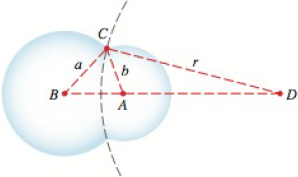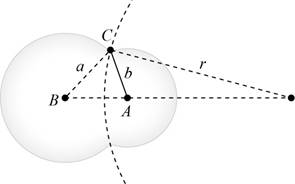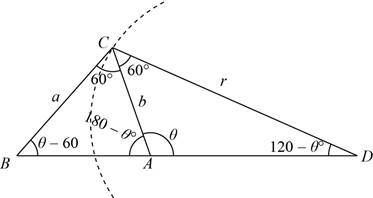
Soap Bubbles When two bubbles cling together in midair, their common surface is part of a sphere whose center D lies on the line passing through the centers of the bubbles (see the figure). Also, ∠ACB and ∠ACD each have measure 60°.
- (a) Show that the radius r of the common face is given by
[Hint: Use the Law of Sines together with the fact that an angle θ and its supplement 180° − θ have the same sine.]
- (b) Find the radius of the common face if the radii of the bubbles are 4 cm and 3 cm.
- (c) What shape does the common face take if the two bubbles have equal radii?

(a)
To show: The radius of common face formed, when two bubbles cling together is given as,
Explanation of Solution
To prove the radius of common face between two bubbles, assume one unknown angle as a variable and evaluate the angles with respect to variable.
The given figure is,

Figure (1)
It is given that
Let assume the unknown angle
Angles
That is
And angle
Substitute
That is,
Similarly angle
Substitute the value of
That is,
Draw the figure of triangle and show above angles.

Figure (1)
The law of sine for triangle,
Where,
- X, Y and Z are the angles of triangle
- x, y and z are the sides with respective to angles.
Apply law of sine in
Substitute
That is,
Similarly apply law of sine in
Add both the equations (5) and (6).
Use the trigonometric identity
Further simplify the equation as,
Hence, the radius of common face formed is,
(b)
To find: The radius of common face when two bubbles cling together.
Answer to Problem 44E
The radius of common face is 12 cm.
Explanation of Solution
Given:
The radii of bubbles that cling together to form the common face are given as 4 and 3 cm respectively.
Calculation:
From part (a), the radius of common face formed, when two bubbles cling together is given as,
Substitute 4 for a and 3 for b.
Thus, the radius of common face is 12 cm.
(c)
The shape of common face formed by two bubbles of same radii.
Explanation of Solution
From part (a), the radius of common face formed, when two bubbles cling together is given as,
It is given that bubbles have same radii. Assume the radii of bubbles as
The radius is not defined.
Thus, the shape of common face is a straight line.
Chapter 6 Solutions
Precalculus: Mathematics for Calculus - 6th Edition
- 1. Consider the function f(x) whose graph is given below. Use the graph to determine the following: 2 a) All x for which f'(x) is positive. b) All x for which f'(x) is negative. 2 -2 c) The x for which f'(x) is zero. (please depict this on the graph)arrow_forward4. Suppose that the population of a certain collection of rare Brazilian ants is given by P(t)=(t+100) In(t+2), Where t represents the time in days. Find and interpret the rates of change of the population on the third day and on the tenth day.arrow_forwardFind all values of x for f (x)=(x²-4) 4 where the tangent line is horizontal. 5. Find the slope of the tangent line to the graph of f(x)=-√8x+1 at x=1. Write the equation of the tangent line.arrow_forward
- 3. Find the derivative of each function. Label with appropriate derivative notation showing both dependent and independent variables. f(t)=4t(2t⭑+4)³ a. f(t)=4t (2t+4)³ (Answer must be factored.) b. y= 3 1 (2x³-4) 6arrow_forward4.3 The Chain Rule 1. {Algebra review} Let f(x)=2x²-5 x and g(x)=6x+2. Find f[g(−5)]. 2. {Algebra review} Write h(x)=√√8x-3 as the composite of two functions f(x) and g(x). (There may be more than one way to do this.)arrow_forward4.4 Derivatives of Exponential Functions 1. Find derivatives of the functions defined as follows. a. g(t)=-3.4e b. y=e√x c. f(x)=(4x³+2)e³* d. y=- x²arrow_forward
- 4.5 Derivatives of Logarithmic Functions 1. Find the derivative of each function. a) y=ln (-3x) b) f(u)=nu c) 9(x)=x-1 lnxarrow_forward3. If the total revenue received from the sale of x items is given by R(x)=30ln (2x+1), While the total cost to produce x items is C(x)=✗, find the following. a) The marginal revenue b) The profit function P(x) (Hint: P(x)=R(x)-C(x)} c) The marginal profit when x=20 d) Interpret the results of part c).arrow_forward2. The sales of a new personal computer (in thousands) are given by S(t)=100-90€-04: Where t represents time in years. Find and interpret the rate of change of sales at each time. a) After 1 year b) After 5 years c) What is happening to the rate of change of sales as time goes on? d) Does the rate of change of sales ever equal zero?arrow_forward
- 2. Find the equation of the line tangent to the graph of f(x)=ln(x²+5) at the point (-1, In 6). Do not approximate numbers.arrow_forward6. The number of viewers of a television series introduced several years ago is approximated by N(t)=(60+2t2/3,1arrow_forwardsolve please, thank youarrow_forwardarrow_back_iosSEE MORE QUESTIONSarrow_forward_ios
 Calculus: Early TranscendentalsCalculusISBN:9781285741550Author:James StewartPublisher:Cengage Learning
Calculus: Early TranscendentalsCalculusISBN:9781285741550Author:James StewartPublisher:Cengage Learning Thomas' Calculus (14th Edition)CalculusISBN:9780134438986Author:Joel R. Hass, Christopher E. Heil, Maurice D. WeirPublisher:PEARSON
Thomas' Calculus (14th Edition)CalculusISBN:9780134438986Author:Joel R. Hass, Christopher E. Heil, Maurice D. WeirPublisher:PEARSON Calculus: Early Transcendentals (3rd Edition)CalculusISBN:9780134763644Author:William L. Briggs, Lyle Cochran, Bernard Gillett, Eric SchulzPublisher:PEARSON
Calculus: Early Transcendentals (3rd Edition)CalculusISBN:9780134763644Author:William L. Briggs, Lyle Cochran, Bernard Gillett, Eric SchulzPublisher:PEARSON Calculus: Early TranscendentalsCalculusISBN:9781319050740Author:Jon Rogawski, Colin Adams, Robert FranzosaPublisher:W. H. Freeman
Calculus: Early TranscendentalsCalculusISBN:9781319050740Author:Jon Rogawski, Colin Adams, Robert FranzosaPublisher:W. H. Freeman
 Calculus: Early Transcendental FunctionsCalculusISBN:9781337552516Author:Ron Larson, Bruce H. EdwardsPublisher:Cengage Learning
Calculus: Early Transcendental FunctionsCalculusISBN:9781337552516Author:Ron Larson, Bruce H. EdwardsPublisher:Cengage Learning





